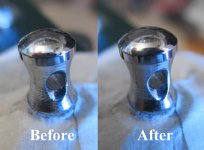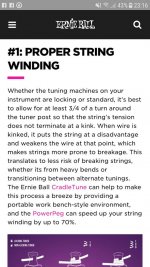You are using an out of date browser. It may not display this or other websites correctly.
You should upgrade or use an alternative browser.
You should upgrade or use an alternative browser.
- Thread starter Spudmurphy
- Start date
DrKev
Moderator
Yes, strings can break at the sharp angle where they meet the edge of the hole in the tuning post. But I would think there needs to be significant wear at the edge of the hole for breakage to occur. See photo here...

Note the notches and pitting on the edge of the "before" post. The "after" is the result of 30 seconds with fine grit wet-and-dry sandpaper rolled up into a tiny stick and rubbed across the front of the hole. No more breakage.
I think EBMMs advice here is not bad advice though I don't know how useful it ultimately is. But I doubt it will negatively affect tunign stability so I'm not worred. It's certainly nothing to create a furore over.
What I really want to know is this:
With standard tuners, the rule is "tune up to pitch" for best tuning stability. But with locking tuners many people say "tune down to pitch". Why? I've never once heard a good explanation.

Note the notches and pitting on the edge of the "before" post. The "after" is the result of 30 seconds with fine grit wet-and-dry sandpaper rolled up into a tiny stick and rubbed across the front of the hole. No more breakage.
I think EBMMs advice here is not bad advice though I don't know how useful it ultimately is. But I doubt it will negatively affect tunign stability so I'm not worred. It's certainly nothing to create a furore over.
What I really want to know is this:
With standard tuners, the rule is "tune up to pitch" for best tuning stability. But with locking tuners many people say "tune down to pitch". Why? I've never once heard a good explanation.
Last edited:
Spudmurphy
Well-known member
The popular media site that rhymes with race and hook had a post from a "local lad" who received some negative responses to his post regarding advice provided by EB on their strings.
The process/protocol that you and I have seen over the years on the forum has been for the post to be at 12/6 o'clock, pull the string through, and tune to pitch. I don't have one of my guitars here with me right now but that process results in little winding around the post.
I think the point of issue is that EB in their string packaging are advising a 3/4 turn .... and to be honest I'm not fully understanding why a 3/4 turn is better than hardly any turn at all? The 3/4 turn doesn't seem conducive to eliminating any risks of string breakage , and in my simple mind seems to add to the risk?
Oh well, maybe somebody from the string department can chime in ?
The process/protocol that you and I have seen over the years on the forum has been for the post to be at 12/6 o'clock, pull the string through, and tune to pitch. I don't have one of my guitars here with me right now but that process results in little winding around the post.
I think the point of issue is that EB in their string packaging are advising a 3/4 turn .... and to be honest I'm not fully understanding why a 3/4 turn is better than hardly any turn at all? The 3/4 turn doesn't seem conducive to eliminating any risks of string breakage , and in my simple mind seems to add to the risk?
Oh well, maybe somebody from the string department can chime in ?
DrKev
Moderator
No, I get it. It has to do with bearing surfaces.
Tuning post as a clock face.
Imagine the bridge below us, below 6 o'clock. String is winding anticlockwise. The point where the string will sharply bend and insert into the tuning post, let's call it the break point.
Start with the tuning hole aligned vertically (i.e. 12/6) and pull the string straight through the hole. The string is not yet bent so no stress at the break point.
We start winding the string. The break point moves anticlockwise from 6 o'clock up towards 3 o'clock and as we do the string starts to bend at that point. String tension increases, with a force pulling downwards towards the bridge (parallel to 6 o'clock). The stress at the bend in the string at the break point increases too.
Once the break point of the string is at 3 o'clock, the tuning post starts to become a bearing surface that distributes the tension and takes some of the increasing stress off the break point. e.g. when the break point is at, say, 2 o'clock, the surface of the tuning post between 2 and 3 is supporting the string and therefore taking some of the force. The direction of the force is always towards 6 o'clock, so the bearing pressure is not evenly distributed across all points of the bearing surface but depends on the angle relative to vertical, i.e. bearing pressure increases from minimum (zero) at 3 o'clock to maximum at 12 o'clock and minimum at 9 o'clock (the magical 3/4 of a turn).
See?
Tuning post as a clock face.
Imagine the bridge below us, below 6 o'clock. String is winding anticlockwise. The point where the string will sharply bend and insert into the tuning post, let's call it the break point.
Start with the tuning hole aligned vertically (i.e. 12/6) and pull the string straight through the hole. The string is not yet bent so no stress at the break point.
We start winding the string. The break point moves anticlockwise from 6 o'clock up towards 3 o'clock and as we do the string starts to bend at that point. String tension increases, with a force pulling downwards towards the bridge (parallel to 6 o'clock). The stress at the bend in the string at the break point increases too.
Once the break point of the string is at 3 o'clock, the tuning post starts to become a bearing surface that distributes the tension and takes some of the increasing stress off the break point. e.g. when the break point is at, say, 2 o'clock, the surface of the tuning post between 2 and 3 is supporting the string and therefore taking some of the force. The direction of the force is always towards 6 o'clock, so the bearing pressure is not evenly distributed across all points of the bearing surface but depends on the angle relative to vertical, i.e. bearing pressure increases from minimum (zero) at 3 o'clock to maximum at 12 o'clock and minimum at 9 o'clock (the magical 3/4 of a turn).
See?
Last edited:
Spudmurphy
Well-known member
Well I had to read that a few times (whilst looking at my clock on the mantelpiece) and I understood that . well this now becomes our "Standard Work Instruction" (SWI) then ? 
tbonesullivan
Well-known member
This is one reason I really don't seek out locking tuners. While they make some things easier, I have had more issues with string breakage at the tuning peg with locking tuners.
However, not an extremely large number. As long as there are no burrs on the surface, it shouldn't matter as much.
However, not an extremely large number. As long as there are no burrs on the surface, it shouldn't matter as much.
steevo
Well-known member
My silo special is the only guitar Ive ever had with locking tuners and its by far the best system ive ever used on any guitar. The only issue ive experienced lately is strings becoming unwound at the ball end and the solution im hoping has worked is to dab some solder over the length of the winding.



